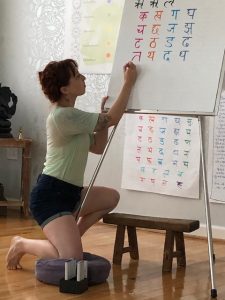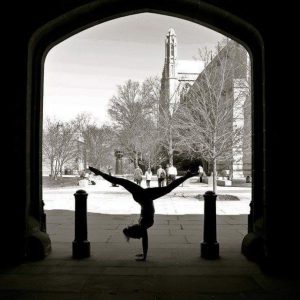SANSKRIT, THE LANGUAGE OF VIBRATION. Interview with Sarah LaFleur.
Sarah please introduce yourself .
My name is Sarah LaFleur. I have been practicing ashtanga yoga for eight years. I am a ERYT 500 hour yoga teacher, Sanskrit teacher for the American Sanskrit Institute, and director/owner of Pranava Yoga in Collingswood, NJ. I also am a writer and graduate student in marriage, couples, and family counseling.
Who should learn the Sanskrit language?
I think the cheery adage, “If you can breathe, you can do yoga!” applies to Sanskrit study as well. The beautiful aspect of learning Sanskrit with ASI is that we emphasize connection to the palate. Rather than encouraging students to make associations to other languages or strategize to commit lesson or letter to memory, we ground our teaching in the primary point of focus of resonance. This means that every student is given maximal access to his or her own experience. Sanskrit is similar to Mysore practice in that way. For this reason, anyone interested in having a deeper understanding of and experience with him or herself should take this course.
What is the best way to learn Sanskrit?

Sanskrit Alphabet. Sanskrit Level 1 weekend course.
In considering the best way to learn Sanskrit, I can only speak from my own experience, relating what has worked for me and what I have seen work for other students. First, I think it is important to be given the space to have one’s own experience. ASI was developed to make Sanskrit as accessible as possible for anyone interested in experiencing the power of the language. As stated before, this access is founded on the point of focus of resonance. This means that rather than trying to mimic sounds or relate letters I am familiar with to a Sanskrit letter, I focus on giving that letter expression in the palate. In the beginning, ASI focuses mostly on chanting and developing intimacy with the palate. I mostly chanted and explored the mouth positions before I learned to read the Devanagari fluently or learned more about grammar. I found committing to this point of focus as I learned the alphabet grounded my study in an important way that is bearing fruit years later. Learning with attention given to my own experience rather than collecting information is the kind of learning I have found the most valuable. Do you want to be transformed or informed? Do you want to have the experience yourself of sound, or have it distilled by someone else? How much do you value your own experience? ASI’s learning model is grounded in transformative learning and this is the only method I can speak to because it is the method that has worked for me.
Vyass Houston, the founder of ASI, writes the following in Devavani, a collection of essays about Sanskrit:
“The nature of a sacred language such as Sanskrit is the direct way that it models life, or accesses thro
ugh the purity of its sound and rhythms, the perfection and beauty of life that we all experienced as children. On our first exposure to Sanskrit, we reconnect with that purity and joy, and then with the desire to secure that again in our lives, decide that we must learn the language. On a very deep level, it is a decision to nourish our spirit, and reestablish our oneness with life” (p. 43).
Why is Sanskrit called the language of vibration and why is it important?

Sarah LaFleur. American Sanskrit Institute.



Comments are closed.